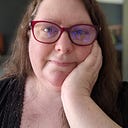How I Made Up With Makeup
--
Even though I’m in my 40s, I feel pretty clueless when it comes to makeup. I’m lucky if my foundation doesn’t look patchy and my mascara isn’t clumped at the tips of my lashes. When I look at the faces of other women, I wonder why their makeup looks so good. Who taught them? How did they learn to draw eyeliner so straight? Why isn’t their lipstick wearing off?
My experience with the stuff has been haphazard at best. It didn’t help that my mom, a quiet feminist, didn’t want me wearing it. “You’re so beautiful just the way you are,” she’d say. “You don’t need makeup. Wait until you’re older — then you might want some color on your face, but not now.” Despite her advice, she didn’t stop me from trying it, and I blew plenty of my preteen allowance money on eyeshadow, mascara and Dr. Pepper lip gloss from the local drugstore. When it came to applying it, I was also on my own. My mom’s hand with makeup was pretty good, but she didn’t offer me any tips.
In seventh grade, my classmates would crowd around the bathroom mirror at school, making sure their bright blue eyeshadow or thick mascara hadn’t smudged. I wanted to look like them, candy-colored and fearless, but I was too shy to ask those cool, aloof girls to show me what to do. On my own, I couldn’t find any eyeshadow colors that didn’t make my 12-year-old face look haggard, and my mascara somehow always melted into dark half-moons under my eyes by the end of the day. Foundation, when I tried it, felt heavy, like a mask over my skin, which it basically was. As I experimented, I soon figured out two things: I had no idea what I was doing, and I didn’t like the sticky, powdery feeling of makeup on my skin anyway.
I didn’t give it another serious try until I was well into adulthood; in some ways, my mom got her wish. I’ll never know whether she meant to teach me about makeup when I was old enough, because she died when I was 22. I had no idea how to learn what I was doing. In the meantime, the women around me seemed either to have figured out makeup or settled into lifestyle that didn’t involve such embellishments. Asking my makeup-savvy friends for tips felt like admitting I’d failed to learn a basic skill, like tying my shoes.
The one time I had someone to teach me, it went badly. After I was asked to be a bridesmaid in my dad’s second wedding, my soon-to-be-stepmom set me up with the woman who would be handling our makeup on their wedding day. As I sat in her department-store makeover chair, she applied layers of color to my eyes, cheeks and lips. When she was finished, I looked good, but my eyes stung and I couldn’t smile or move my face like a normal person. I asked if I could wash it off.
She looked as though I’d slapped her. “You should keep it on. For a few hours. To see how it wears,” she said.
“But I don’t like how it feels,” I said. I left the store, went home, and stripped my face back down to bare skin, relieved but feeling guilty that I couldn’t get the hang of this supposedly basic aspect of womanhood.
Eventually, by trying things out, asking my friends shy questions and scouring the Internet, I started to find my way. I learned, for example, that there’s such a thing as lightweight foundation and waterproof mascara. Watching girls apply makeup on YouTube made up for the teenage hours I didn’t spend doing the same among friends. I learned, too, that I was sensitive to some pigments and other ingredients in cosmetics, which made it easier to avoid things that stung my eyes or sent my skin into an itchy tailspin.
At one point, I decided I wanted to tame my exuberant eyebrows, but Googling for “how to pluck your eyebrows” was less helpful than you’d think. There are sites that describe how to determine the shape of your new brows, but most leave out the basic mechanics of how to actually tweeze the hairs. They assume you already know. Eventually I stumbled upon “The Lazy Crossdresser” by transgender author Charlie Jane (then Charles) Anders, which helps men learn to adopt aspects of femininity, either part-time or full-time. Although I wasn’t her book’s intended audience, it’s the perfect guide for anyone coming to makeup and other aspects of feminization later in life, in part because it assumes you didn’t learn about them growing up. Its instructions on how to prune one’s brows were just what I was looking for, and I’ve followed them ever since.
These days, my makeup routine — when I bother — is still pretty minimalist, aimed at evening out my red nose and cheeks, hiding the effects of sleep deprivation and playing up my eyes, which are my favorite feature. I still feel pretty clueless; I still haven’t found an eyeshadow that doesn’t hurt my eyes and I’m not brave enough to wear red lipstick outside the house. But thanks to countless YouTube videos, Sephora’s unlimited makeup-return policy, and at least one transgender writer, I’m mostly happy with where I am. And I think my mom would have been, too.
